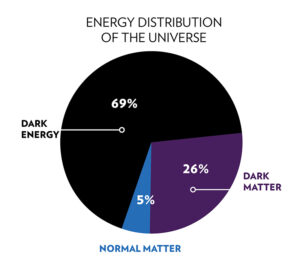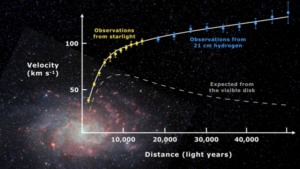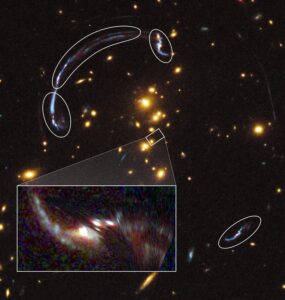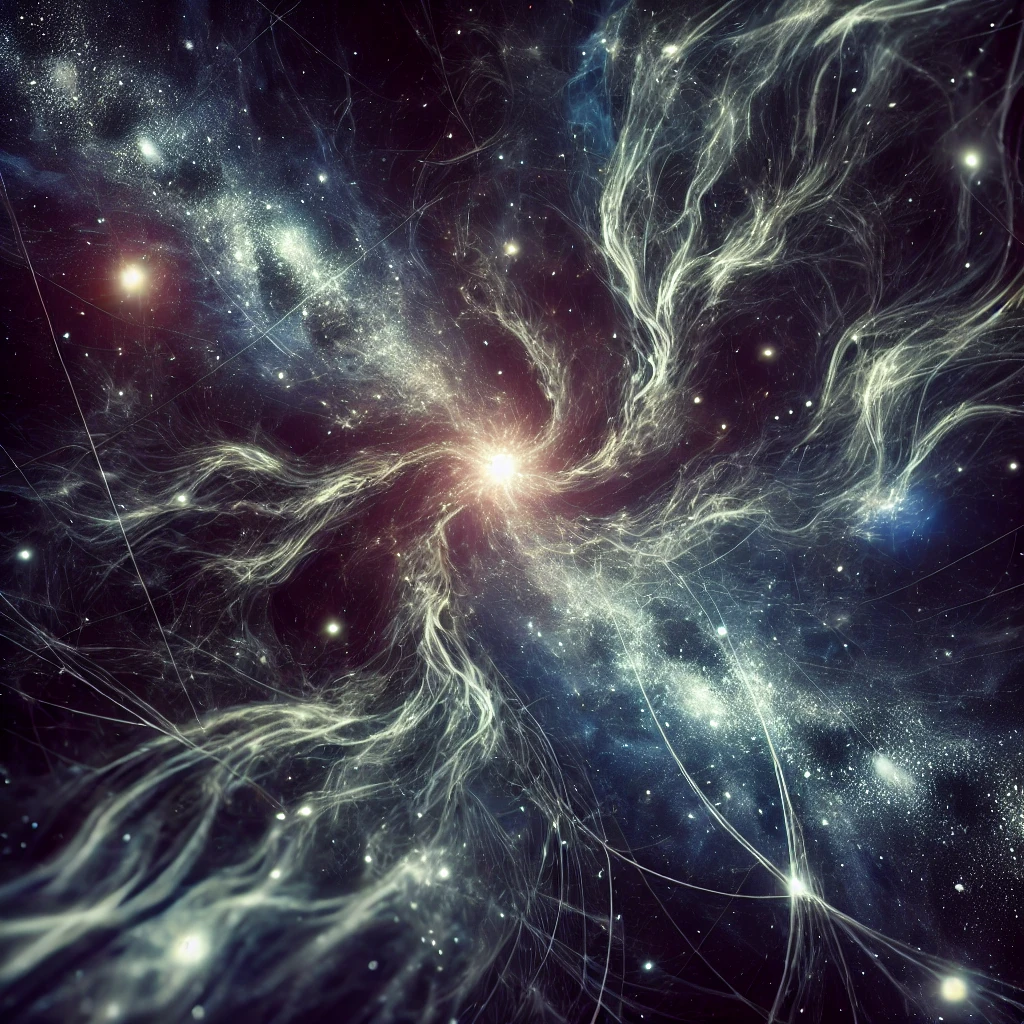You and I are made of normal matter.
This matter builds the world around us and is made up of fundamental particles such as electrons and quarks. Additionally, there are those that act as messengers for the known forces of the universe – photons, gluons and the W/Z bosons. This entire family of particles makes up the wide gamut of cosmic objects that we know of.
Or so we thought.
Mathematical calculations and observations reveal a starkly different reality of our cosmos. The universe we inhabit is not just made of normal matter. There are two additional ‘dark’ components – Dark Matter and Dark Energy.
At present, the total matter-energy content of the universe is 69% dark energy, 26% dark matter and only 5% normal matter. Of the total matter content, the fundamental particles, which make up planets, stars, and galaxies, comprise only 16%!

Source – https://chandra.harvard.edu/chronicle/0108/universe/pie.jpg
So, what is ‘dark matter’, which takes up 84% of the total matter content in the universe?
What is Dark Matter?
In the 1930s, astronomers noticed a problem with their observations of galaxies.
While studying how stars moved in our solar neighborhood, eminent Dutch radio astrophysicist Jan Oort noted that the amount of mass observed is lesser than what should be present in the galaxy.
H.W. Babcock reported a similar inference for our neighbor, the Andromeda Galaxy. Swiss astrophysicist Fritz Zwicky took it a step further and observed a large group of galaxies, often called a galaxy cluster. He studied the motion of galaxies at the outer edges of a cluster (viz the Coma Cluster) and observed that they were moving faster than what should be possible given the number of galaxies present.
Improved observations in the 1970s confirmed the growing suspicions in the astronomy community. There is something out there that we cannot see, but can observe its influence on normal matter. It was thus named ‘dark matter’.
Dark matter is a type of matter that doesn’t interact with normal matter through electromagnetic forces. It neither emits nor absorbs any kind of light. It’s invisible. This means that we can’t use our state-of-the-art telescopes to study it.
However, it has a strong influence on large cosmic objects. Out of the four known forces of the universe, it only interacts with normal matter through the force of gravity.
How do we know about Dark Matter?
Planets orbit their host star. Stars orbit the supermassive black hole at the center of the galaxy. Galaxies orbit the center of their cluster.
According to Johannes Kepler’s laws of planetary motion, the velocity of an object orbiting a center is inversely proportional to the square root of the distance between the two.
The farther away the object is, the slower it moves. A plot of the object’s velocity against its distance from the center is called the system’s rotation curve. In normal scenarios, it is expected to decrease. This is observed in our solar system. Planets like Uranus and Neptune move slower than Mercury and Venus.
Galaxies upend this expectation. The rotation curves of almost all galaxies are either flat or, more surprisingly, increase. Such a plot implies that matter at the edge of the galaxy is moving faster than that near the center. Such peculiar observations demand the consideration of extra mass. Since this additional mass is not observed through our telescopes, this obviously points toward dark matter.
Such anomalous rotation curves are observed for galaxy clusters as well.
 Galaxy Rotation Curve. Source – https://en.wikipedia.org/wiki/Galaxy_rotation_curve
Galaxy Rotation Curve. Source – https://en.wikipedia.org/wiki/Galaxy_rotation_curve
There is another gravitational effect that indicates the presence of dark matter in our universe.
According to Einstein’s General Theory of Relativity, mass can bend the path that light takes to travel from one point to another. This is similar to what everyday optical lenses do.
If a massive cosmic object – a galaxy or a cluster of galaxies – is sitting in between a bright source and an observer on Earth, then the light’s path will get distorted, and it will travel around the object to reach Earth. The observer will notice multiple curved images of the bright source around the intervening medium. This effect is called Gravitational Lensing.
The images’ geometry reveals, amongst other quantities, the mass of the intervening object. If it is higher than the observed amount of mass, then it indicates the presence of extra mass that is contributing to the distortion. As usual, this mass is due to dark matter.
 Gravitational Lensing. Source – https://news.uchicago.edu/story/gravitational-lens-reveals-details-distant-ancient-galaxy
Gravitational Lensing. Source – https://news.uchicago.edu/story/gravitational-lens-reveals-details-distant-ancient-galaxy
The importance of dark matter is apparent through numerical simulations as well. Several simulations, such as Illustris and EAGLE, show that without dark matter, galaxies would evolve slowly. They would take much longer to reach their current size. Stars, planets and life itself would not have formed without dark matter’s extra push.
What is Dark Matter made of?
Normal matter is made of protons and neutrons, which are, in turn, made of quarks. They are held together in the nucleus of the atom by gluons.
What about dark matter? Is it made of ‘dark-protons’ and ‘dark-neutrons’, sitting in a nucleus of the ‘dark-atom’?
We don’t know yet. All we have are a slew of hypotheses of what dark matter could be.
A popular candidate is the Weakly Interacting Massive Particle, or WIMP. The standard model of particle physics best describes the properties of the fundamental particles that make up normal matter. Additionally, it can describe three of the four known forces as well – electromagnetism, and strong and weak nuclear force.
However, the standard model is not complete yet. For instance, it doesn’t include gravity. The other three forces are mediated through force-particles, or bosons. Their existence has been experimentally verified.
But gravity, as best described by Einstein’s General Theory of Relativity, works not through particles, but through the curvature of spacetime. This fundamental difference leads to mathematical inconsistencies and prohibits it from joining the standard model.
One solution is supersymmetry, which, in simple words, is a theoretical framework that predicts that every matter-particle has a force-particle counterpart, and vice versa. This improves the standard model, and predicts the existence of a particle that could make up dark matter. This particle interacts feebly with normal matter via gravity only.
Another potential candidate is the sterile neutrino. A neutrino is a charge-less fundamental particle with extremely low mass. It interacts with other particles via the weak nuclear force only. In contrast, the sterile version is hypothesized to interact with normal matter via gravity only. Since it is charge-less and has low mass, it is a prime dark matter candidate.
There is a camp in the astronomy community that puts forth a radically different proposition. Instead of new particles, they believe that our understanding of gravity itself needs to be modified. This framework is aptly named Modified Newtonian Dynamics (MoND).
It can successfully explain the anomalous rotation curves of galaxies. But it falls short for other effects – gravitational lensing being one of them. Thus, this framework hasn’t received widespread support, and the camp continues to be a small group.
The presence of dark matter in the universe is irrefutable. Its influence on galaxies and galaxy clusters opens a window for us to understand its properties. But that window is small. To widen the opening, billions of dollars have been spent in designing clever experiments to detect these elusive particles. Let’s take a look at a few of such attempts in the next article.


